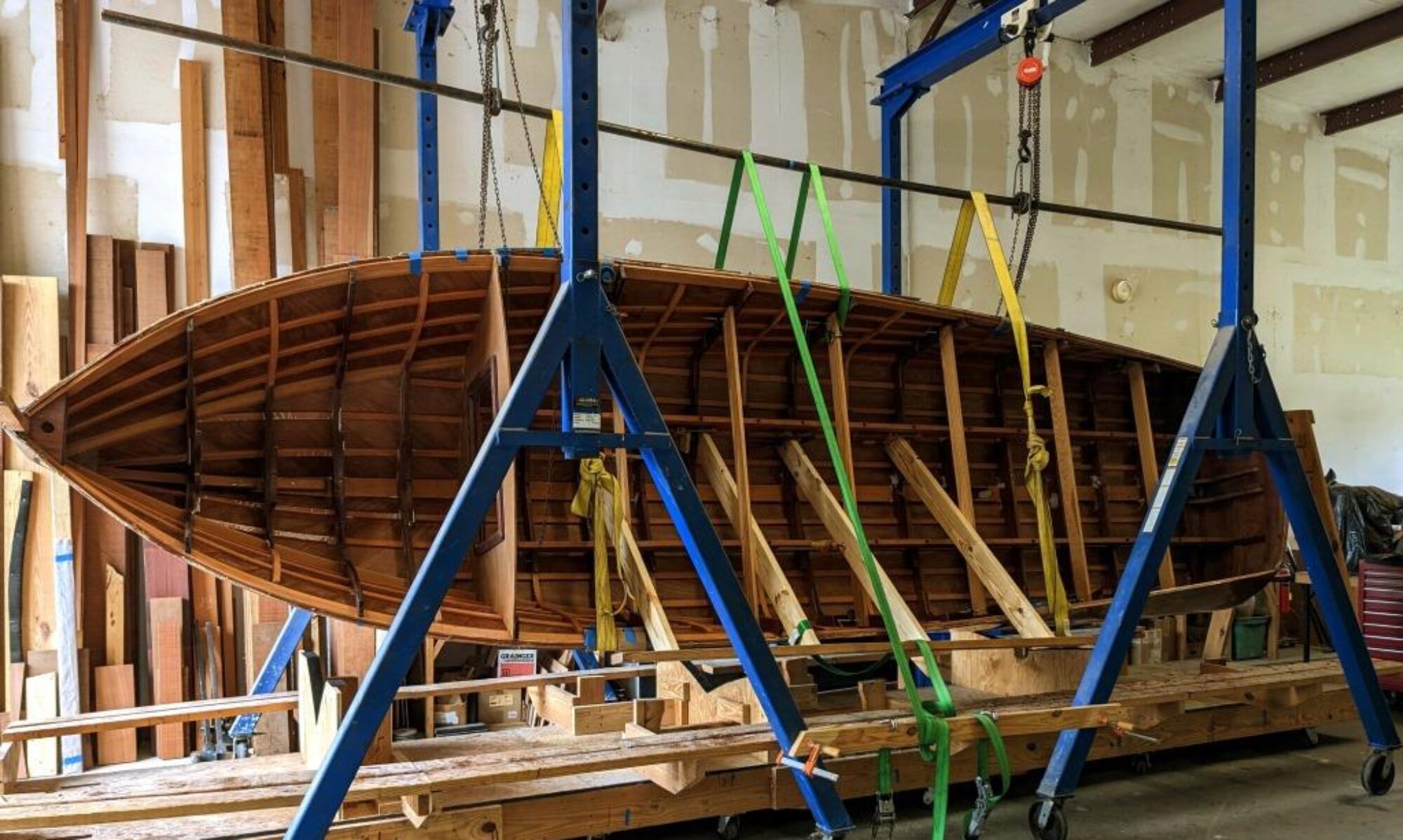
Having set up the framework for the boat, with all the structural pieces glued in place, it’s time to put a skin on it. Traditionally, boats were either Carvel planked (with seams that are ideally invisible to the eye because they’re flush and tight), or Lapstrake planked (where one edge overlaps the edge of the adjacent plank, creating “strakes”). In both of these traditional methods, solid lumber is used. Long boards are attached to the framing with calking in the seams to keep them watertight.
But we’re using a more modern method called Cold Molding. In this method, we’ll build up layers of 1/8″ thick veneer in the shape of the hull, gluing each layer to the others with epoxy. We’re creating plywood the thickness we need, in the shape of the hull. It’s called cold molding because before epoxy was developed, this type of lamination required heat and pressure.

In the picture at left, you’ll notice full sheets of 1/8″ Okoume plywood roughly in the shape of the bottom of the boat. These sheets are pre-finished with at least 4 coats of clear epoxy on the interior face (which is up in the photo), sanding between each coat, to seal the wood and make it as waterproof as possible. Plywood, though expensive compared to veneer strips worth the added expense because it will provide an air tight surface to vacuum bag subsequent layers to. The exterior face, which you can’t see here, is unfinished. It will be coated with thickened epoxy when the next layer is added.

The planks or sheets are held in place with staples until the epoxy cures. Then the staples are no longer needed and should be removed unless you’re using plastic staples.
In the diagonal planking, you inevitably end up with some of the edges not lining up precisely with the adjacent plank. In this case, sometimes a small wood block temporarily tacked to both edges will hold the edges in alignment until the epoxy cures.

Finally, notice that all the diagonal planking is edge glued in addition to being glued to the frame. Again, this is so we’ll have an air tight layer to vacuum bag the subsequent layers to. More on that in the next post.

Fascinating process and interesting terminology. boy howdy, enjoy charting your progress…
Thanks man! It’s fun when the shape emerges.
Great to see this planking process, thanks for sharing. I have a couple of questions, which will help me apply this approach to my model, if you don’t mind:
1. How many layers do you plan in total and how will you orientate each layer
2. It looks like you started the angled strips at the bulkhead frame and worked forwards: how did you decide where to start?
3. The small alignment blocks: how are they fastened? In the Gougeon book they suggest a backing block into which the alignment block is fastened with screws.
Your post has motivated me to restart work on my 1/5 scale model of this lovely boat – I’ve been putting it off because the weather’s been really miserable here!
Hi Steve,
Great to hear from you.
To answer your questions:
1. I’ll have 4 layers total. First layer is plywood as you know (which itself is composed of 3 plys). Second and third layers will be 1/8 inch Alaskan yellow cedar veneer in 6″ wide strips. These will be oriented at approximately a 45 degree angle. The second layer will run opposite direction from the strips in the first layer forward section. Third layer will run opposite to the second. This gives a cross hatch pattern providing strength. Remember, wood is strongest in tension. Final layer will be 3/16 African mahogany (Utile) running longitudinally to mimic the old style wooden runabouts.
2. Angled strips start 1 frame aft of the bulkhead (i.e. frame 4) on the topsides and at the bulkhead on the bottom. I decided by placing a sheet on the frame and finding where I could no longer get it to accept the compound curvature of the hull without complaining too much.
3. I had very little alignment problem because I was careful to avoid edge setting the planks. I was able to get them to work by just stapling from the outside with one staple bridging the edges of the two planks. Does that make sense? If not I’ll try to find a closeup picture for you.
Thanks Tim, very clear.
By the way, remind me where in the world you are? The weather is really hot here. I’ve been getting up at 4am to beat the heat. Before I started this, I nearly got caught out applying one of the large side panels. I didn’t have time to do a really thorough cleaning of all the squeeze out on the inside. That just means I’ll get to spend some quality time grinding and sanding it out after I flip the boat. But as you can imagine, it’s far easier to clean before the glue sets up.
I’m in Laax, A ski resort in eastern Switzerland. This summer has been very wet and not so warm, a complete contrast to the conditions you guys have experienced this summer. As I work on my balcony table I’ve not been very motivated to work on the boat!
I remember now. Dreadful weather in much of Europe this summer. Please send me some pictures when you get back to work on the boat.
Hi Tim,
Great work. I’m building the same design in Australia and tracking behind you about 6months! Its great to be able to watch yours taking shape and the techniques at each stage. Thanks for being pathfinder to my project!!
Cheers
Thanks Chris. Glad to be of help if I can. What part of Australia?